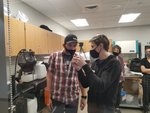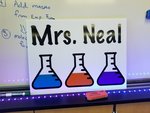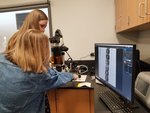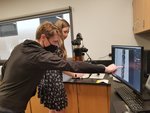



Wendy Neal, a chemistry and molecular genetics teacher at W.F. West High School in Chehalis, first began thinking about zebrafish several years ago, when one of her students asked about the possibility of using them for a research project. It wasn’t until Neal visited the Aquatics Research Core at the UW Medicine Institute for Stem Cell and Regenerative Medicine (ISCRM) that the dream became a reality.
The zebrafish is a small tropical freshwater fish native to India, Pakistan, Bangladesh, Nepal and Myanmar. About the size of a small aquarium fish, the conveniently transparent zebrafish has become a standard research model for researchers around the world studying cellular biology, genetics and disease. There are several reasons for this. For starters, 70% of human genes are also found in zebrafish. Zebrafish also develop and reproduce quickly — a female can produce hundreds of eggs a week, meaning experiments proceed more quickly than they would in mice or rats. And zebrafish are able to regrow organs and other body parts — leading scientists in university and biotech labs to wonder if humans might have a similar untapped ability.
At ISCRM, zebrafish help researchers investigate how organisms develop and study diseases like osteoporosis, diabetes, muscle disorders and other conditions that impact human health. It turns out, zebrafish are useful for inquisitive high school students as well.
Sparking a Love for Science
In August 2018, a group of science-minded high school students took part in a two-day STEM camp focused on human biology, biotechnology, genetics, and other topics related to regenerative medicine. The camp took place in the new STEM wing at W.F. West High School — the program and facility had been strongly backed by Orin Smith, the former UW Regent whose generous gifts have supported the launch of ISCRM and sustained its growth over the last 10 years.
At the time of the STEM camp, Lynn Panther, a teacher on special assignment for the Chehalis School District, spoke to the importance of the relationship.
“This partnership with the University of Washington has been an amazing experience for kids from the whole region,” she said. “My hope is that learning from UW researchers and scientists will spark an interest in science, open their minds to opportunities they wouldn’t have known about, and show them that they can do these jobs, too.”
In 2018 and 2019, Neal and her students made several ensuing visits to ISCRM’s South Lake Union Campus, where they acquired the requisite knowledge to start their own zebrafish colony and conduct basic investigations in their own lab back at school. Funding from the Chehalis Foundation supported the purchase of sophisticated equipment, including a high-powered dissecting microscope.
Soon, students at W.F. West were running research projects using zebrafish as a model. Trevor Jensen designed experiments to identify a gene that causes scleroderma, a disease that leads to tightening of the skin in the hands and can affect the lungs, heart and muscles. Daniel Santiago studied how acidic water environments affected the expression of a particular gene.
Unfortunately, Jenson and Santiago, who both graduated in 2020, were thwarted by the COVID-19 pandemic, which also delayed the full use of the dissecting microscope. That changed in April 2021. As students began returning safely to the classroom, ISCRM also returned to W.F. West to help Neal and several current and former students revive their zebrafish research with a hands-on orientation and training.
After sharing a few tips on basic care for zebrafish colonies, ISCRM representatives Jeanot Muster and Silvia Marchiano demonstrated how to use a micro-injector to inject dye into a fish membrane. Because the tiny eggs are too small to see with the naked eye, the injection must be performed with the help of a microscope and a carefully-guided, razor-thin needle.
Abby Kay, a senior, has already used zebrafish to study how a cancer-fighting drug influences the expression of a gene called GATA3. Learning to use the micro-injector was another highlight in her high school science career.
“I knew that I wanted to go into a biology field, so I took molecular genetics and I really loved it,” she said. “There’s so much to learn and so many opportunities to help others. I’d like to research genetic diseases.”
Ava Meller, a junior, echoed her classmate.
“I was inspired by Abby because she was taking molecular genetics her junior year,” she said. “So I decided to take molecular genetics at the same time I was taking chemistry. I just think DNA is fascinating, how something so functional can create such diversity.”
For her project, Meller explored the link between embryonic ethanol exposure and the expression of the gene Fox C1A in zebrafish.
Both Kay and Meller plan to carry their love of science with them to college. Abby plans to study molecular and cellular development at the University of Washington this fall. She has thoughts of becoming a genetic counselor. Meller added, “This is something I really want to do in the future. I definitely want to go into genetics for a career. I want to do research. And I’d really like to do something that can help people.”
As for Neal, every interaction with ISCRM is another chance to grow as an educator, she said.
“I’m still learning myself,” she said. “Sometimes the students will pick up on something that I didn’t and just run with it. And by the time the year’s out, they know more than I do about a project or how to use a lot of the equipment. ISCRM has helped us see how zebrafish research works, how useful it is for science, and how it’s actually an easy thing to do in high school.”